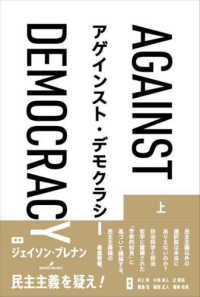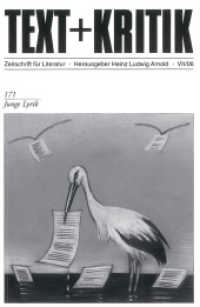- ホーム
- > 洋書
- > 英文書
- > History / World
Full Description
This first edition text examines the remarkable histories of the societies and people who fostered Eurasian trade and communication in the almost two millennia before 1500 C.E. A study in the early history of "globalization," the commercial and cultural exchanges explored in this volume provide students not only with a greater knowledge of the past, but also a deeper understanding of our world today.
Contents
An IntroductionEurasian Silkroads The Silk Three Interrelated Ecological Zones Inside the Urban-agricultural Zone Inside the Pastoral Zone Inside the Taiga Forest Zone Exchanges Among the Zones The Significance of Horses Chapter 1: The Origins of the Silk Roads: Silks and Horses on the Chinese Frontier Steppe vs. Sown on the Chinese Frontier The Xiongnu, The Yuezhi, and the Chinese The Yuezhi-Kushan in Tuhara (formerly Bactria) The Political, Cultural, and Symbolic Significance of Horses, Chariots, and Silk Chapter 2: An Overseas Silk Road: Roman Empire Traders in India, the Yuezhi-Kushan Kingdom, and the Development of Mahayana Buddhism The Roman Empire Traders/h4> The Arabian Peninsula and the Early Trade in Aromatic Wood Resins Gan Ying and a Chinese Attempt to Find the Sea Markets The Cosmopolitan Kushan Empire Mahayana Buddhism and its Spread to China Chapter 3: The Desert Routes: (2nd C BCE to 5th C CE) The Hexi Corridor and the Great Wall Oases around the Takla Makan Desert Buddhist Establishments on the Desert Routes Desert Routes on the Roman Frontier Hellenistic Cities under the Seleucids The Silk Trade in Eurasia's Western Deserts Chapter 4: Zoroastriamism, Christianity, and Buddhism: Political Turmoil and a New Relationship between Empire and Religion Upheavals Religions, Institutions, and Values Buddhist Networks Zoroastrian Networks Christian Networks The Byzantine Empire's Government Silk Monopoly The Tang Empire and Government Restrictions on Some Varieties of Silk Chapter 5: Trade and Communication under the Muslim System The Islamic Attitude toward Trade Islamic Currency and the Tiraz System The Significance of Textiles Sericulture and Trade in the Islamic Domain The Spread of Paper-making and Books Scholarly Pursuits Chapter 6: Oceans and Seas, 900-1300 The Origins of the Route between China and Sri Lanka The Maritime Trade of the Umayyad and Abbasid Caliphates The Fatimid Caliphate and the Ayyubid Dynasty in Egypt The Mediterranean Trade The Indian Subcontinent as the Center of Southern Ocean Trade and the Rise of Cola An Age of Chinese Seafaring Chapter 7: The Mongol Conquests and a New Order of Trade The Mongols and Trade Cross-cultural Communications and Trade Sponsored by Mongol Rulers Tent Culture and Textiles Growth and Development of the Seafaring TradeNER(01): WOW








